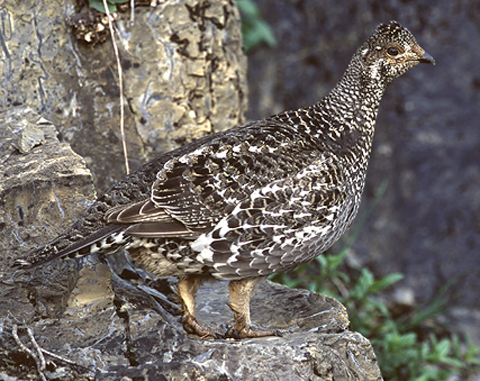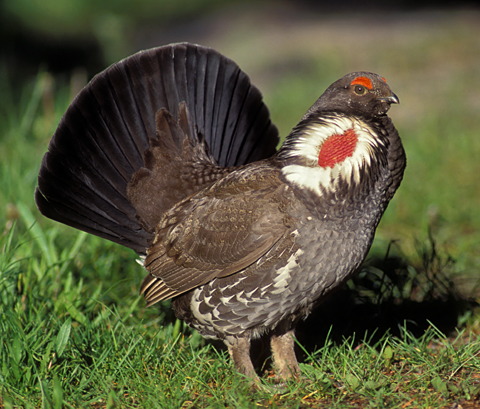Encounters
While Clark and the main party worked their way up Jefferson’s River on 1 August 1805, through what appeared to be another “gate” of the Rocky Mountains, Lewis proceeded overland on the north side of the river in the hope of coming upon some of Sacagawea‘s people, the Lemhi Shoshone. As he climbed through the high mountains he came upon a flock of “the black or dark brown phesants.”
this bird is fully a third larger than the common phesant of the Atlantic states. it’s form is much the same. it is booted nearly to the toes and the male has not the tufts of long black feathers on the sides of the neck which are so conspicuous in those of the Atlantic. their colour is a uniform dark brown with a small mixture of yellow or yelloish brown specks on some of the feathers particularly those of the tail, tho’ the extremities of these are perfectly black for about one inch. the eye is nearly black, the iris has a small dash of yellowish brown. the feathers of the tail are reather longer than that of our phesant or pattridge as they are Called in the Eastern States; are the same in number or eighteen and all nearly of the same length, those in the intermediate part being somewhat longest. the flesh of this bird is white and agreeably flavored.
Classifications
Fifteen years later, naturalist Thomas Say observed Lewis’s “black or dark brown phesant” near the site of the Corps’ Council Bluff, gave the bird a precise scientific description, and assigned it an official name, Dendragapus obscurus (Say). The first half of the binomial (den-dra-ga-us), denoting the genus, is a Latin word meaning “tree-loving”; the specific epithet, obscurus (ob-skoo-rus), means “shaded, dark, dusky.” Elliott Coues (pronounced cowz) classified this grouse in the subspecies richardsonii (the last two letters are pronounced ee-eye), after the Scottish naturalist and explorer Sir John Richardson (1787-1865), but the “lumpers” prefer to focus on a singular species.[1]Regarding Richardson, see “John Franklin and Company,” in Spruce Grouse. It has earned a number of other common names, including dusky grouse, gray grouse, hooter (from its seductive mating call), mountain grouse, pine grouse, pine hen, and sooty grouse. According to the current AOU Check-list of North American Birds (2004), its most common name is blue grouse—although no one seems to know why.
Habitat
Blue grouse favor high mountain meadows in summer and fall, often feeding on insects and seeds on exposed ridges like Spring Mountain, Bald Mountain, or Indian Post Office. The Corps’ hunters would have soon learned that a blue’s standard strategy when startled or threatened is to soar straight out from a mountainside, thereby gaining altitude quickly with minimum effort, and steering a shallow glide toward the crowns of the tallest trees below. The hunters, their objective being to kill deer or bear, probably did not carry fowling pieces (shotguns), and shooting one in flight with a rifle, aiming more or less straight up in the air, would have been the test of a fine weapon and a superior marksman.
Contrary to what one might expect, blue grouse move upslope with the onset of winter, to feed on the needles of conifers, and sometimes roost under the snow. In May and June they return to lower breeding grounds in open woods, where, with fanned tail tipped forward, head drawn back, and wings dragging on the ground, they strut before the females. They inflate the purplish-red or yellow air sacs in their necks to produce resonant hooting and groaning sounds. Very erotic behavior—for a blue grouse.
Sources
Edwin James, comp., Account of An Expedition from Pittsburgh to the Rocky Mountains Performed in the Years 1819 and ’20 . . . under the command of Stephen H. Long (2 vols., Philadelphia: H. C. Carey, 1823).
John K. Terres, The Audubon Society Encyclopedia of North American Birds (New York: Wings Books, 1980).
Notes
| ↑1 | Regarding Richardson, see “John Franklin and Company,” in Spruce Grouse. |
|---|


